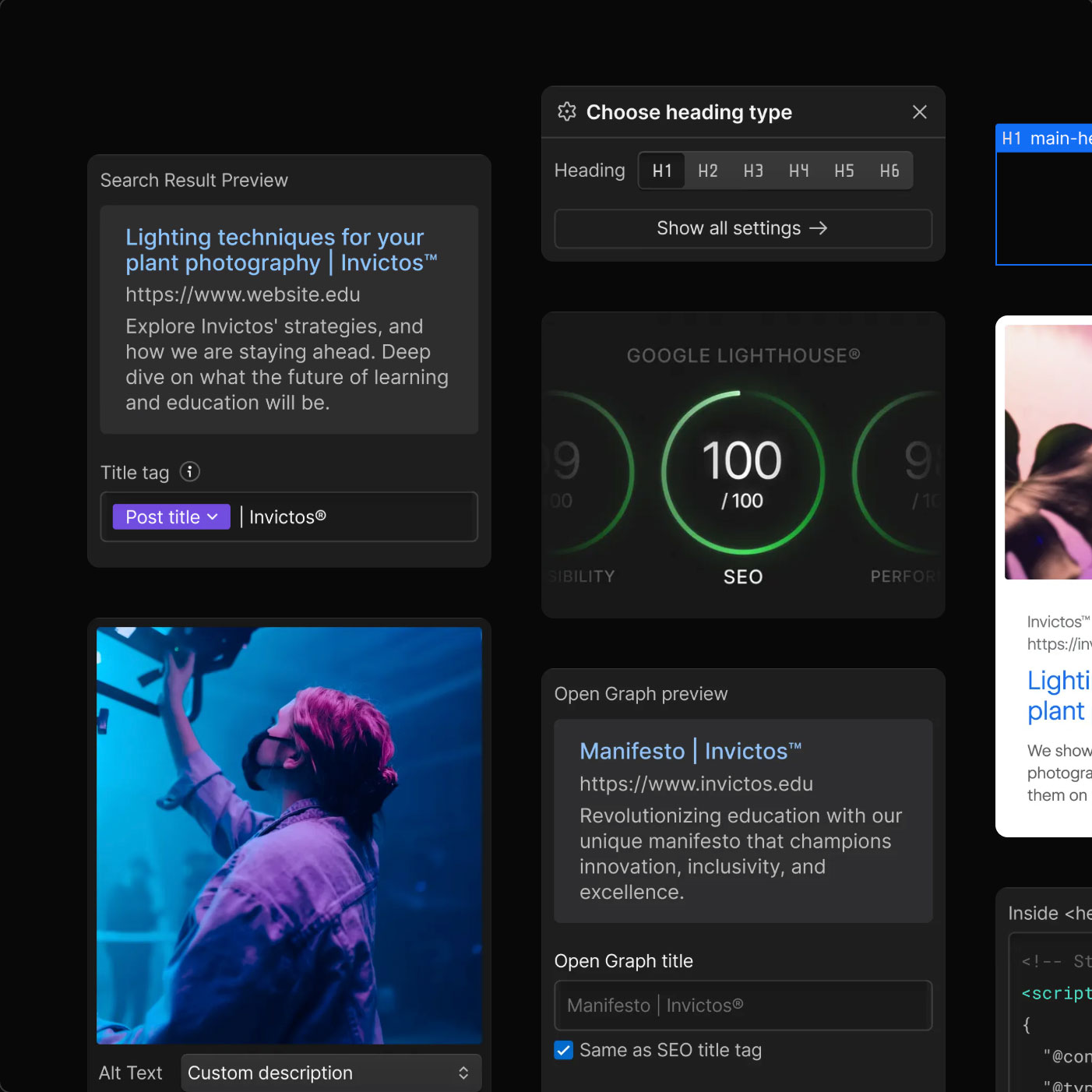Is a Webflow website good for SEO?
Many companies are used to having to install a whole range of plugins to make it easy to find. This is especially normal in WordPress: you use Yoast for titles and descriptions, another plugin for redirects, another one for schema, and another for sitemaps. This makes management more complex and your website slower. In Webflow, this works completely differently. Almost all important SEO settings are built in by default, so you immediately have a clean, fast and stable basis.


Standard SEO settings without plugins
In Webflow, you don't need to install Yoast, RankMath, or separate tools to control basic SEO. Everything you use every day is built-in:
- Title tags
- Meta descriptions
- Alt text for images
- Canonical Etiquetas
- Open Graph settings
- NoIndex/NoFollow options per page
- Automatic XML sitemap
- Automatic SSL
- Robots settings per page
- Redirects (also wildcard)
- Schema markup via custom code or dynamically via Collections
This makes Webflow clearer, more reliable and faster than systems that rely heavily on plugins.

Clean code that Google understands
A big part of SEO is about technology. That's what Webflow excels at. The platform generates clean HTML and CSS without unnecessary clutter. No page-builder code, no duplicate style sheets, no plugin scripts that slow each other down. Therefore:
- Load pages faster
- Will your site be crawled more easily
- Do you score better on Core Web Vitals
- Does performance remain stable
Hosting runs worldwide on a CDN, images are automatically optimized and lazy loading is enabled by default. You don't have to change any settings for anything, it just works.
Full control over on-page SEO
Especially with large websites or content platforms, it is important that SEO settings work dynamically. In Webflow, you can set everything up at Collection level:
- Dynamic title tags
- Dynamic meta descriptions
- Dynamic OG images
- Alt texts that are automatically generated from fields
- SEO-friendly slugs
- Internal link structures that you can easily expand
Ideal for blogs, cases, events, destinations, jobs and other content that needs to be scalable.

Technical SEO is almost fully automated
Webflow takes care of a number of things that you often do manually or with plugins in WordPress:
- Automatic sitemap
- Automatic CSS and JS minification
- Automatic caching
- Responsive design out of the box
- No risk of duplicate content due to canonical options
- Noindex for test or campaign pages
The platform takes care of many technical burdens, so you can focus on content.

Redirects without separate tools
As soon as you migrate or reorganize your website, redirects are crucial. In WordPress, you almost always need a plugin for that. In Webflow, you can set this up directly yourself, including wildcard redirects when you move entire folders. This makes migrations clearer and less error-prone. An example:
/blog/old/ * → /blog/new/ *

Why Webflow SEO is more stable than plugin-driven systems
Many WordPress SEO problems are not caused by SEO itself, but by conflicting plugins. One update can break your site or slow down scripts. In Webflow, you work within one system that is continuously tested. No conflicts, no plugin stress, and no unexpected updates that affect the basics. Your SEO remains stable and predictable.
Why this is important for your website
With Webflow, you immediately get a technically strong SEO basis that is light, fast and scalable. You can manage all the important parts yourself, your site stays clean, and you don't need any extra tools to set the foundation. That makes Webflow a very reliable choice for companies that want to rank well in Google without hassle.
Do you want a website that is technically accurate, loads quickly and is optimized for search engines without plugins? Webflow is one of the strongest platforms to achieve that.

Check it out



